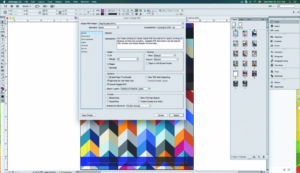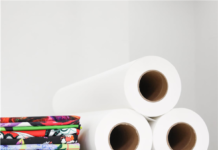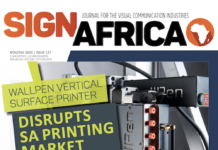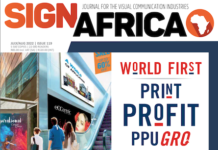Marcelo Girón, DPI Insights/FLAAR Reports says that a never-ending battle is the one of graphic designers vs. printer operators: whether the designer did not prepare the file correctly, or that the colours do not match the ones on file, or that a piece of the final art was cut, etc.
We could spend the whole day making excuses and arguments. In order to avoid any of these, I will give you a guide on how graphic designers should correctly prepare files for printing, as well as some aspects that printer operators should take into account. This article appears in Sign Africa Journal.
Software

What software you choose will depend on what kind of artwork you are preparing. A problem is that many printing companies do not always keep their software up to date. These will cause compatibility problems, so you must be very careful with every detail at the time of exporting your file. It is recommended you always export your printing file in an earlier version so it can be opened without a problem. Take care of essential aspects such as colour mode, convert typographies to path, use images in the correct colour mode, margins, etc.
Checklist

We are going to use an InDesign file as an example. We must be very aware that the printing operator will not take the time to modify any artwork. The files will be printed as they come, so we have to have everything under control to avoid surprises.
• Check that the document size is correct.
• Verify that we have the adequate margins and bleeds (the printing cut is not perfect so there should always be a printing bleed).
• Ensure that the PDF is exported with the same colour profile in the InDesign workspace.
• Monitor the inks. In principle, you can use RGB or CMYK (be sure to ask you printer operator before you start working on your file unless you need to print with special inks, such as PANTONE.
• Monitor that all images have the appropriate resolution (300dpi recommended).
• Pay attention to special elements, such as UV coating layers or cutting dies, which must be created as spot colours and overprinting.
• One of the most important points is typographies. This causes great headaches, so the first thing we must do is export all the typographies used in the document, or better yet convert the typographies to paths. But you have to evaluate the pros and cons of doing this. For smaller documents, it is better to convert typographies to path, but for multiple page documents such as books, it is advisable to provide typographies, otherwise the files will become huge.
Final Artworks That Include Finishing
The printed materials with finishes are prepared in a special way, so you should consider the following:
Whenever an artwork is sent to print with a cutting die, it is convenient to attach the cutting die line with its cuts and slits. This should go in a separate document of the design that you want to print and in vector format. We have to add 2cm of extra print around the design as a bleed. It must be with a figure of a totally different colour so that it stands out and there is no confusion. Special care must be taken with very small letters and thin lines.
The artworks that use coating on specific places must be attached to another layer of the document or in another document. All the places where we want to apply the coating should be reserved, and represented as black vector colour. One of the best things I have learned at the time of preparing final artworks, is that you should apply all of these principles from the beginning. Make good use of your layers, sort by colours, styles and elements in all the different programmes. This will allow you to understand and get to know your document in a better way so that the printer operators can easily find any element.


Printers Or Designers: Who Is To Blame For Errors?
Designers should be concerned about doing orderly work and detailing all the important aspects in the different documents. They should review photos, typographies and any element that can be modified, review every detail of the PDF file in case it is a very long document, or the handling of colour in a PDF file. As a designer, you must demand the corresponding printed proofs of the document so that you can see a preliminary image before authorising the print run and, if necessary, do corrections if there is still time.
Like many things in life, good communication is key. In this type of work, in my opinion, the printer operator should not just grab the file and print it. They should take the time to review and understand it, as well as confirm with the designer the work that is wanted, hence the printed proofs. So, neither the designer nor the printer operator are solely responsible for errors, and lack of communication is to blame.
DPI INSIGHTS/FLAAR REPORTS www.flaar-reports.org















